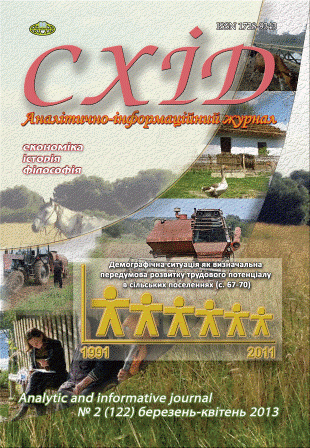Demographic situation as a major factor to develop labour potential in rural areas
DOI:
https://doi.org/10.21847/1728-9343.2013.2(122).13460Keywords:
labour potential, demographic situation, depopulation, demographic policy, regional demographic policyAbstract
The article analyses the demographic situation in rural areas of Ukraine as a prerequisite of development of labour potential within their limits. It is shown that the demographic situation in rural areas of Ukraine is characterized, region by region, with the predominance of negative tendencies that are manifested in the decrease of rural population, general and natural. While the population in Ukraine has decreased in general from 46929525 to 45778534 over the period of 2006-2011 making a loss of 1150991 people, the rural population lost 714930 people (decreased from 15051815 to14336885 people), all regions being the losers. Special attention is paid to such regions as those of Chernihiv, Vynnitsia, Zhytomyr, Poltava where the natural basis for the reproduction of rural population had become narrower by 2011, and so has the labour resource. More peasants were born only in the Autonomous Republic of the Crimea and Thranscarpathian Region, and a rise in the natural growth of rural population had been observed the region of Rivne and Thranscarpathian one. The depopulation of rural areas is already limiting the possibilities of the physical base to increase a labour potential and it causes a real threat to the national security, to the genetic fund of the Ukrainian people and to the development of labour potential in general. The article stresses the necessity to work out and implement a reasonably weighed demographic policy in Ukraine as well as regional demographic policy so as to improve the demographic situation as a base to renew and develop the labour potential of rural areasDownloads
References
Гончаренко І. В. Соціально-економічний розвиток сільських територій регіону: проблеми теорії та практики : [монографія] / І. В. Гончаренко. - Львів, 2009. - С. 12.
Дирбавка О. Демографічно-трудовий потенціал села [Електронний ресурс] / О. Дирбавка. - Режим доступу : http://conftiapv.at.ua.
Ключник А. В. Зайнятість населення сільських територій: проблеми та стратегічні напрями їх вирішення / А. В. Ключ¬ник // Регіональна економіка. - 2011. - № 1. - С. 134.
Сільське господарство України. 2010 рік : [стат. зб.] / Державна служба статистики України. - К., 2011. - С. 29.
Скиба Т. В. Детермінанти розвитку сільського підпри¬ємництва / Т. В. Скиба // Регіональна економіка. - 2012. - № 2. - С. 57.
Славова В. П. Економіко-енергетична система сталого розвитку сільських територій / В. П. Славова, О. В. Коваленко // Вісник аграрної науки. - 2007. - № 9. - С. 69.
Соціальні індикатори рівня життя населення : [стат. зб.] / Державна служба статистики України. - К., 2011. - С. 9, 29-31.
Чисельність наявного населення України на 1 січня 2011 року : [стат. зб.] / Державна служба статистики України. - К., 2011. - С. 8, 17.
Honcharenko I. V. (2009), Sotsialno-ekonomichnyi rozvytok silskykh terytorii rehionu, Lviv, р. 12.
Dyrbavka O., Demohrafichno-trudovyi potentsial sela, available at: http://conftiapv.at.ua.
Kliuchnyk A. V. (2011), Rehionalna ekonomika, No. 1, р. 134.
State Statistics Service of Ukraine (2011), Silske hospo¬darstvo Ukrainy. 2010 rik, Kyiv, р. 29.
Skyba T. V. (2012), Rehionalna ekonomika, No. 2, р. 57.
Slavova V. P., Kovalenko O. V. (2007), Visnyk ahrarnoi nauky, No. 9, р. 69.
State Statistics Service of Ukraine (2011), Sotsialni indy¬katory rivnia zhyttia naselennia, Kyiv, рр. 9, 29-31.
State Statistics Service of Ukraine (2011), Chyselnist na¬iavnoho naselennia Ukrainy na 1 sichnia 2011 roku, Kyiv, рр. 8, 17.
Downloads
Published
How to Cite
Issue
Section
License
Copyright (c) 2013 Roman Chornyi, Liubov Shevchuk

This work is licensed under a Creative Commons Attribution-NonCommercial-NoDerivatives 4.0 International License.
1. Authors bear responsibility for the accuracy of facts, quotations, numbers and names used.
2. Manuscripts are not sent back.
3. The publisher does not always agree with the authors' opinion.
4. The authors reserve the right to authorship of the work and pass the first publication right of this work to the journal under the terms of a Creative Commons Attribution-NonCommercial-NoDerivatives 4.0 International License. This license allows others to distribute (copy) the published work for non-commercial purposes, provided there is mandatory attribution to its authors and a link to the first publication in our journal.
5. The authors have the right to conclude separate supplement agreements that relate to non-exclusive work distribution in the form in which it has been published by the journal (for example, to upload the work to the online storage of the journal or publish it as part of a monograph), provided that the reference to the first publication of the work in this journal is included.

